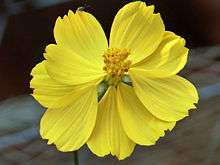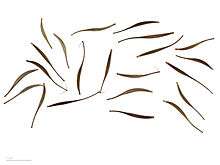Cosmos sulphureus
| Cosmos sulphureus | |
|---|---|
 | |
| Scientific classification | |
| Kingdom: | Plantae |
| (unranked): | Angiosperms |
| (unranked): | Eudicots |
| (unranked): | Asterids |
| Order: | Asterales |
| Family: | Asteraceae |
| Genus: | Cosmos |
| Species: | C. sulphureus |
| Binomial name | |
| Cosmos sulphureus Cav. | |
| Synonyms[1] | |
| |
Cosmos sulphureus is also known as Sulfur Cosmos and Yellow Cosmos. It is native to Mexico, Central America, and northern South America, and naturalized in other parts of North and South America as well as in Europe, Asia, and Australia.[2][3][4][5][6][7][8]


This species of Cosmos is considered a half-hardy annual, although plants may re-appear via self-sowing for several years. Its foliage is opposite and pinnately divided. The plant height varies from 1-7 feet (30-210 cm). The original and its cultivars appear in shades of yellow, orange, and red. It is especially popular in Korea and Japan, where it is often seen in mass plantings along roadsides, following an initiative pursued by the Korean-Japanese botanist Woo Jang-choon.
This plant was declared invasive by the United States Southeast Exotic Pest Plant Council in 1996.[9]
Some of the varieties of Cosmos sulphureus in cultivation today include:
- 'Klondyke Mix', 'Polidor' consists of a variety of colors in shades from yellow to orange and scarlet
- 'Ladybird Dwarf Red', 'Ladybird Dwarf Gold', 'Ladybird Dwarf Orange', and 'Ladybird Dwarf Lemon' are shorter than the species. Another cultivar is named "Bright Eyes".
Growth characteristics of this plant include[10]
- Germination takes between 7 and 21 days at the optimal temperature of 75 degrees Fahrenheit; flowering begins between 50 and 60 days after germination
- It prefers a soil pH between 6.0 and 8.5, reflecting its native habitat in the alkaline regions of Central America
- Flowering is best in full sun, although partial shade is tolerated
- The plant is tolerant to drought after germination, and is seldom subject to insect or disease damage; this vigor is attested by its status as a pest in some areas of the United States
The flowers of all Cosmos attract birds and butterflies, including the Monarch butterfly. Cosmos sulphureus is featured in the 1997 Japanese film Remembering the Cosmos Flower.
Gallery
-

Cosmos sulphureus in Orange flower
-
_1200.jpg)
Cosmos sulphureus with Bee
-
.jpg)
Bud of Cosmos sulphureus
-

Cosmos sulphureus in Kerala
References
- ↑ Flann, C (ed) 2009+ Global Compositae Checklist
- ↑ Flora of North America, Vol. 21 Page 205 Cosmos sulphureus Cavanilles, Icon. 1: 56, plate 79. 1791.
- ↑ Flora of China Vol. 20-21 Page 857 硫磺菊 liu huang ju Cosmos sulphureus Cavanilles, Icon. 1: 56. 1791.
- ↑ Jørgensen, P. M., M. H. Nee & S. G. Beck. (eds.) 2014. Catálogo de las plantas vasculares de Bolivia, Monographs in systematic botany from the Missouri Botanical Garden (1–2): i–viii, 1–1744.
- ↑ Nash, D. L. 1976. Tribe V, Heliantheae. En: Nash, D.L. & Williams, L.O. (Eds), Flora of Guatemal a - Part XII. Fieldiana, Botany 24(12): 181–361, 503–570
- ↑ Dodson, C.H., A.H. Gentry & F.M. Valverde Badillo. 1985. La Flora de Jauneche: Los Ríos, Ecuador 1–512. Banco Central del Ecuador, Quito
- ↑ Strother, J. L. 1999. Compositae–Heliantheae s. l. 5: 1–232. In D.E. Breedlove (ed.) Flora of Chiapas. California Academy of Sciences, San Francisco
- ↑ Hokche, O., P. E. Berry & O. Huber. (eds.) 2008. Nuevo Catálogo de la Flora Vascular de Venezuela 1–859. Fundación Instituto Botánico de Venezuela, Caracas
- ↑ US Department of Agriculture Plant Profile of Cosmos sulphureus
- ↑ Plant Answers, Texas A&M University, Cosmos history and cultivation
External links
- Jepson Manual Treatment
- Calphotos Photo gallery, University of California
- Royal Horticultural Society